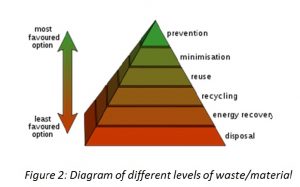In Dharamshala the Clean UpperDharamshala Programme (CUDP), together with Lha Charitable Trust, is working to keep Dhasa “Clean and Green” – but there is so much more to this issue than removing rubbish!All the earth’s resources are limited. We therefore need to use them wisely – otherwise they may disappear. Currently, the consumption of many resources is reaching unsustainable levels. And many materials that we use are wasted.
Developed countries generate the most waste by weight per person; and China more than India. What happens to that waste?

A good way of considering waste and material use is this waste diagram.
Prevention asks the most important question. “Do I really need that product?” An example for prevention might be to give an experience rather than buying a gift that might not be used.
Minimisation asks to reduce the use of a material. “How long do I need a shower?” would be an example.Showering uses water and energy and creates waste water.
Reuse asks about multiple uses of the same materials. A ‘waste’ to one person may be a ‘resource’ to another person. These could include used phones or second hand clothes.
Recycling asks to reuse the basic materials. Water bottles may be recycled so that the plastic can be reused. This would take more energy than ‘reuse’.
Energy recovery can be seen as a form of recycling focused on generating energy from waste. The current status for waste power plants in India is poor.
Disposal is usually in a bin, collected by a waste contractor and taken to landfill.
Littering is not shown in the diagram. It is not a thoughtful form ofdisposal. Not everyone uses bins. The Clean Upper Dharamshala Programme (CUDP) employs 15 sweepers to clean the streets. And Lha Charitable Trust conducts monthly mass cleanups, in which a large quantity of waste is collected from roadsides and places the sweepers cannot reach.
The diagram above does not show the situation in Tibet or Himachal Pradesh – where most waste is either littered or disposed of. If the goal is to climb the diagram to higher and greener levels the government will need to take action to ensure facilities for proper reuse and recycling. But it also means that every person has to try to prevent and minimise the usage of materials.




 Print
Print Email
Email